大学英语精读讲课说课课件
《大学英语精读》第一册 unit.ppt
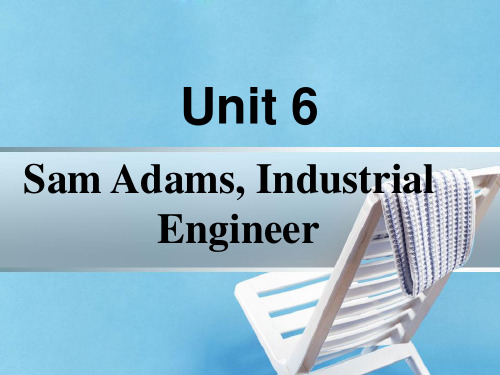
• An industrial engineer’s duties are to coordinate personnel, materials and machinery and to determine the most productive and efficient use of each. He helps plan the production line and designs or adapts details essential to the manufacturing of a product.
Part Division of the Text
Part Lines 1 1 — 12 2 13 — 20 3 21 — 38 4 39 — 56
Main Idea
When a boy, Sam was the “efficient expert” for the family.
When a graduate, Sam was asked to work as a “consultant” in a shirt factory. Sam was greatly surprised by the degree of disorder. Sam put forward some suggestions for the improvement of production and was rewarded by the boss.
现代大学英语精读3第三版教学课件B3U5

现代大学英语精读3第三版教学课件B3U51. 课程介绍本篇教学课件是现代大学英语精读3第三版教材中的第五课单元(Unit 5)的教学课件。
本课旨在帮助学生进一步掌握有关文化差异和交际技巧的知识,并提高他们的英语阅读和理解能力。
本课的主题是文化差异与语言交际,通过讲解和讨论相关话题,培养学生的跨文化交际意识和能力。
1.1 教学目标•了解不同文化背景下的交际差异•掌握谈论文化差异的词汇和表达方式•提高阅读技巧和理解能力•培养跨文化交际意识和能力1.2 教学内容•课文导入•词汇讲解•阅读理解•文化差异与交际技巧讨论•练习与巩固2. 课堂内容2.1 课文导入首先,我们将通过一个小故事来引入本节课的主题。
请看下面这个故事:Mr. Smith, an American businessman, went to China on a business trip. On the first day of his visit, he had a meeting withhis Chinese partners. During the meeting, Mr. Smith crossed his legs, showing the sole of his shoe to the Chinese partners. This action caused great offense to the Chinese partners, as showing the sole of one’s shoe is considered impolite in Chinese culture.通过这个故事,我们可以看到不同文化背景下的交际差异。
在中国文化中,露出鞋底是不礼貌的,而在美国文化中可能没有这样的问题。
这个例子揭示了文化差异对交际的影响。
2.2 词汇讲解在本节课中,我们将学习一些与文化差异和交际技巧相关的词汇和表达方式。
请看下面的表格:单词词性解释cultural adj.文化的difference n.差异、区别communication n.交流、沟通etiquette n.礼仪offend v.冒犯、得罪gesture n.手势misinterpret v.误解appropriate adj.适当的foreign adj.外国的respect n./v.尊重behavior n.行为custom n.习俗tradition n.传统adapt v.适应、调整misunderstand v.误解social adj.社交的interaction n.互动diplomatic adj.外交的sensitive adj.敏感的cultural adj.文化的language n.语言、表达方式custom n.风俗、习惯2.3 阅读理解现在,让我们阅读一篇与文化差异和交际技巧相关的短文,并回答以下问题:Cultural Differences in CommunicationWhen people from different cultures meet and communicate, there are often challenges and misunderstandings due to cultural differences. For example, in some cultures, it is common to maintain direct eye contact during a conversation as a sign of respect and attention, while in other cultures, avoiding eye contact is seen as a sign of respect. Thus, what is considered polite in one culture may be considered impolite in another.Another important aspect of cross-cultural communication is body language and gestures. Different cultures have different meanings behind certain gestures. For example, the。
大学英语精读修订版第四册课件
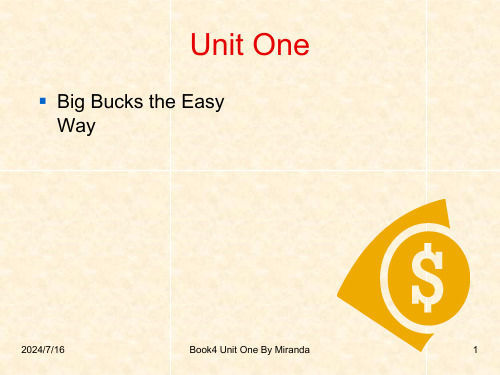
6
▪ 4. delivery n. 1)投递,送交;2)投递的邮件,发送的 货物;3)分娩;4)讲话的方式,演讲风格
▪ ----- Please pay on delivery.
▪ Phr. cash on delivery 货到付现金
▪
take delivery (of sth.) 收到某物
▪
delivery note 货单
8
▪ 8. echo n.回音,回声,共鸣 vi.发出回声,产生回响 vt. 模仿,重复,附和
▪ ----- They echoed their leader’s every word.
▪ ----- He has no original opinion; he is just his brother’s echo.
▪ Phr. echo sth. (back) (指地方)传回回声
▪
echo to/ with sth. (指地方)产生回声
▪ ----- The valley echoed (back) his song.
▪ ----- The hills echoed to the sound of their laughter.
----- He always wears a sour expression.
▪ acid表示讽刺、刻薄或严厉的批评。 ----- an acid remark ----- I read an acid comment on the political situation.
2024/7/16
Book4 Unit One By Miranda
▪ Phr. the company one keeps 经常与之为伍的人;伙伴
大学英语说课讲稿课件PPT
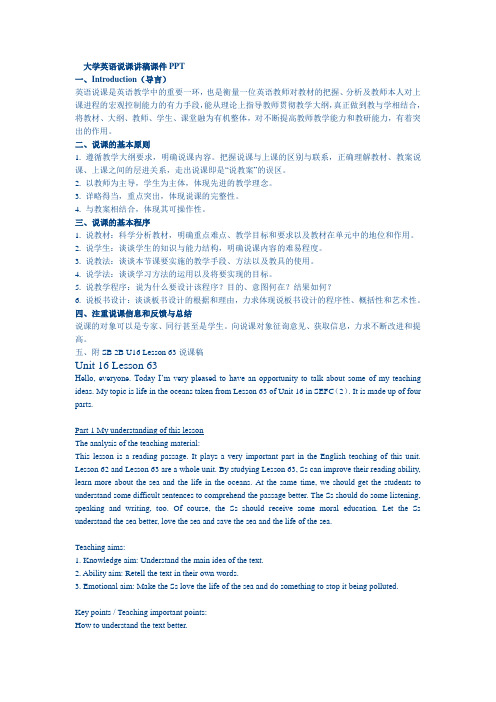
大学英语说课讲稿课件PPT一、Introduction(导言)英语说课是英语教学中的重要一环,也是衡量一位英语教师对教材的把握、分析及教师本人对上课进程的宏观控制能力的有力手段,能从理论上指导教师贯彻教学大纲,真正做到教与学相结合,将教材、大纲、教师、学生、课堂融为有机整体,对不断提高教师教学能力和教研能力,有着突出的作用。
二、说课的基本原则1. 遵循教学大纲要求,明确说课内容。
把握说课与上课的区别与联系,正确理解教材、教案说课、上课之间的层进关系,走出说课即是“说教案”的误区。
2. 以教师为主导,学生为主体,体现先进的教学理念。
3. 详略得当,重点突出,体现说课的完整性。
4. 与教案相结合,体现其可操作性。
三、说课的基本程序1. 说教材:科学分析教材,明确重点难点、教学目标和要求以及教材在单元中的地位和作用。
2. 说学生:谈谈学生的知识与能力结构,明确说课内容的难易程度。
3. 说教法:谈谈本节课要实施的教学手段、方法以及教具的使用。
4. 说学法:谈谈学习方法的运用以及将要实现的目标。
5. 说教学程序:说为什么要设计该程序?目的、意图何在?结果如何?6. 说板书设计:谈谈板书设计的根据和理由,力求体现说板书设计的程序性、概括性和艺术性。
四、注重说课信息和反馈与总结说课的对象可以是专家、同行甚至是学生。
向说课对象征询意见、获取信息,力求不断改进和提高。
五、附SB 2B U16 Lesson 63说课稿Unit 16 Lesson 63Hello, everyone. Today I’m very pleased to hav e an opportunity to talk about some of my teaching ideas. My topic is life in the oceans taken from Lesson 63 of Unit 16 in SEFC(2). It is made up of four parts.Part 1 My understanding of this lessonThe analysis of the teaching material:This lesson is a reading passage. It plays a very important part in the English teaching of this unit. Lesson 62 and Lesson 63 are a whole unit. By studying Lesson 63, Ss can improve their reading ability, learn more about the sea and the life in the oceans. At the same time, we should get the students to understand some difficult sentences to comprehend the passage better. The Ss should do some listening, speaking and writing, too. Of course, the Ss should receive some moral education. Let the Ss understand the sea better, love the sea and save the sea and the life of the sea.Teaching aims:1. Knowledge aim: Understand the main idea of the text.2. Ability aim: Retell the text in their own words.3. Emotional aim: Make the Ss love the life of the sea and do something to stop it being polluted.Key points / Teaching important points:How to understand the text better.Teaching difficult points:1. Use your own words to retell the text.2. Discuss the pollution of the sea and how to save the sea.Something about the Ss:1. The Ss have known something about the sea and sea life through the Internet and other ways.2. They are lack of vocabulary.3. They don’t often use English to express themselves and communicate with others.4. Some Ss are not active in the class because they are afraid of making mistakes.Part 2 My teaching theories, methods and aidsBefore dealing with this lesson, I’ll do my best to carry out the following theories: Make the Ss the real masters in class while the teacher himself acts as director;Combine the language structures with the language functions; Let the students receive some moral education while they are learning the English language.Teaching method:Double activities teaching methodQuestion-and-answer activity teaching methodWatch-and-listen activityFree discussion methodPair work or individual work methodTeaching aids:1. a projector2. a tape recorder3. multimedia4. the blackboardPart 3. Teaching steps / proceduresI have designed the following steps to train their ability of listening, speaking, reading and writing, especially reading ability.The entire steps are:Greetings, Revision, Lead-in and preparation for reading, Fast reading(scanning), Listening, Intensive reading, Preparation for details of the text, Consolidation, Discussion, HomeworkStep 1 GreetingsGreet the whole class as usual.Step 2. Revision1. Ask students some questions to revise the last lesson(show them on the screen).a. How much salt do the oceans contain per thousand parts of water?(35 parts of salt. 3.5% by weight)b. What is coral? Why are corals not found in deep water?c. Why is the Dead Sea called the Dead Sea?2. Check the homework(made a survey about the sea or sea life by surfing the Internet or asking for help from other people). Through this part we can consolidate what they studied yesterday, communicate with others about their survery results and prepare for the new lesson.Step 3. Lead-in and preparation for readingShow them some pictures and let them talk each other, and then use the pictures about sea and life in the oceans to learn new words, for example, Antarctica, huge whale, sperm whale, squid and so on. Purpose: Arouse the students’ intere st of study.Bring in new subject: Life in the oceans.Step 4. Fast readingRead the passage as quickly as they can. I show the questions on the screen and let them get the main idea of each paragraph:1. Why can living things live in such oceans around the Antarctica?2. What does the whale feed on?3. What is the difference between the sperm whale and other whales?Method: Read the text individually, use question—and—answer activity.Purpose: Improve the students’ reading ability.Understand the general idea of each paragraph.Step 5. Listening(book closed)1. Listen to the tape then do an exercise(wb page 90, part 1)2. True or false exercise.(on the screen)Train the Ss’ listening ability and prepare for later exercises.Step 6. Intensive readingRead the passage carefully again and answer some detailed questions on the screen.1. How much does a whale eat at a time?2. Do all the whales feed on small fish?3. How deep can a sperm whale dive?It is also called depth reading or study reading. It means reading for detailed information.Purpose: Further understand the text (Train further reading ability)to find out some different sentences and details of the text.Step 7. Preparation for details of the text on the screen1. ...its heart slows to half its normal speed.slow-v. to become / make slower.2. ing sound wavePresent participle used as adverbial.3. provide sth. for sb.provide sb. with sth.4. at a time: each time5. grow to a length of...Purpose: Train the Ss’ ability of understanding and using laguage.Step 8. Consolidation1. Find out the topic sentences.2. Retell the passage according to the topic sentences.Purpose: I want to know if my students understand the whole text really and if they master what I mean to tell them in this class. What’s more, I want to let them have the ability of introducing and analyzing expression. At the same time, I will write down the topic sentences on the blackboard according to what the students find, so they can retell it easily.Step 9. DiscussionShow them some pictures about the polluted sea and many living things which are in danger and ask them: What are their opinions about it? In order to let them have free choice, I give them another topic: The sea is being polluted. What should they do?Purpose: I mean to give them emotional education. I give them multi-media pictures to arouse their interest of study and their love for life. I mean to make them realize: The sea is in danger!I teach them to do their best to help it and do something from now on. Everyone should do something to love and protect our home.Step 10. HomeworkWrite an article Saving the sea. I want to improve the ability of their writing. At the same time, train the ability of do-it-yourself and looking up the information by themseleves.Part 4. Blackboard designUnit 16 Lesson 63Topic Sentences:1. Some living things can live in Antarctica.(what)2. The whale feeds on small fish.(what)3. The sperm whale feeds on squid.(difference)Discussion:1. The whales are in danger. What’s your opinion about it?2. The sea is being polluted. What should we do?In my opinion, the blackboard design can reflect the teacher’s ability of mastering the text and leading the students to master the text easily.In this text, the design is not easy to write. I write the topic sentences on the blackboard in order to tell the students that this is of the importance in this class. The discussion is of the difficulty.I want to make the design inductive, instructive and artistic.。
大学英语精读4 unit2课件
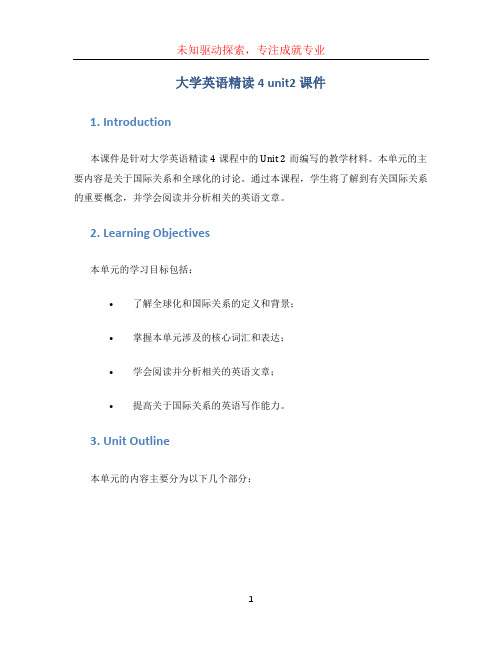
大学英语精读4 unit2课件1. Introduction本课件是针对大学英语精读4课程中的Unit 2而编写的教学材料。
本单元的主要内容是关于国际关系和全球化的讨论。
通过本课程,学生将了解到有关国际关系的重要概念,并学会阅读并分析相关的英语文章。
2. Learning Objectives本单元的学习目标包括:•了解全球化和国际关系的定义和背景;•掌握本单元涉及的核心词汇和表达;•学会阅读并分析相关的英语文章;•提高关于国际关系的英语写作能力。
3. Unit Outline本单元的内容主要分为以下几个部分:3.1 全球化的定义和背景在这一部分,我们将探讨全球化的概念以及对国际关系产生的影响。
学生将了解到全球化的背景和原因,并通过案例分析来深入了解全球化对经济、文化和社会的影响。
3.2 国际关系中的重要概念这一部分将介绍国际关系中的一些重要概念,如国家主权、国际法、联合国等。
学生将学习这些概念的定义和相关的背景知识,并了解它们在实际的国际事务中的应用。
3.3 国际关系中的核心词汇和表达在这一部分,我们将学习与国际关系相关的核心词汇和常用表达。
这些词汇和表达将帮助学生更好地理解相关的文章和进行书面和口头表达。
3.4 阅读和分析相关的英语文章本单元还将包括阅读和分析相关的英语文章的训练。
学生将通过阅读和讨论来进一步理解国际关系的重要议题,并学会从英语文章中提取关键信息。
3.5 提高写作能力在这一部分,我们将进行有关国际关系的英语写作训练。
学生将学习如何撰写关于国际关系的议论文,并提高写作技巧和思维能力。
4. Assessment本单元的评估方式主要包括以下几个方面:•课堂参与和讨论:学生在课堂上积极参与讨论和提问,展示对国际关系的理解和分析能力。
•阅读报告:学生需要阅读指定的英语文章,并撰写阅读报告,分析其内容和观点。
•写作作业:学生需要完成有关国际关系的写作作业,包括议论文和摘要等。
5. Resources为了辅助学习,以下是一些可以参考的资源:•教科书:《大学英语精读4》•课件资料:本课件提供的教学资料和范例•英语词典:如牛津高阶英汉双解词典等,帮助理解核心词汇和表达•网络资源:如相关的学术文章、新闻报道和学术论坛等,帮助扩展阅读和研究的范围6. Conclusion通过本单元的学习,学生将对国际关系和全球化有更深入的理解,并提高相关的阅读和写作能力。
大学英语精读3-U3 why i teach ppt课件
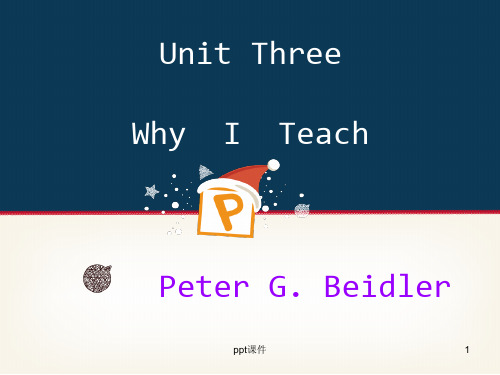
ppt课件
5
Part Division of the Text
Parts 1
Paras 1~3
Main Ideas
Introduce my feelings during the process of teaching.
2
4~11 Tell some reasons why I choose
2. Translate the sentence into Chinese.
当然,我之所以教书不是因为我觉得教书轻松。
ppt课件
8
Line. 7
Paraphrase this sentence.
Teaching is a profession that makes my eyes red for lack of sleep, my palms sweaty because of nervousness and my stomach sinking because I often feel so disappointed with my lectures.
2. Translate this sentence into Chinese.
我有权启迪,有权激发才智,有权开出书目,有权 指点迷津。
ppt课件
13
Line.72
1. Paraphrase this sentence.
I teach because, when I see that my students are beginning to grow and change in front of me, I from time to time find myself growing and changing with them too, as if new life were being breathed into my body. 2. Translate the sentence into Chinese.
大学英语精读说课课件

Why did Marishane invent Drybath?
Creative thinking Paradigm shifts: 范式转变 a major change in the usual way of thinking about something.
Thomas Kuhn(1922-1996) The Structure of Scientific Revolution
4. We should ________ our minds on the following problems.
Rhetoric device
My kids were doing what Copernicus did when he placed the sun at the center of the universe, readjusting the centuriesold paradigm of an Earth-centered system. They were doing what Reuben Mattus did when he renamed his Bronx ice cream Haagen-Dazs and raised the price without changing the product. They were doing what Edward Jenner did when he discovered a vaccination for smallpox by abandoning his quest for a cure.
大学英语精读 说课
说课内容
1 1
2 2 2 3
课程设置
教材分析
教学设计
33
4
大学英语精读第一册Unit1PPT课件
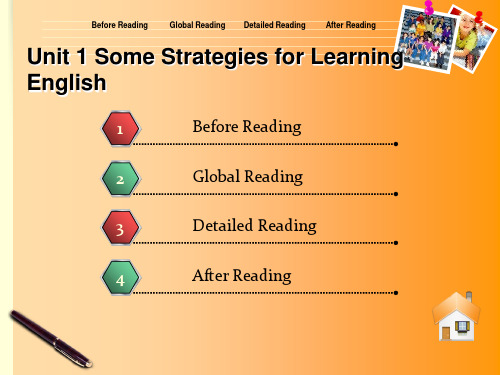
Detailed Reading
Before Reading
Global Reading Detailed Reading
After Reading
Detailed Reading
Word Study Difficult Sentences Important Words
Word Study
• 1. strategy n. • (1)-- 战略学,兵法
• eg:他又问了她一个问题,仅仅是为了延长谈话时间。
• He asked her another question just to prolong the conversation.
• Many superstitious people believe that this medicine can prolong life.
Before Reading
Global Reading Detailed Reading
After Reading
Before Reading
1
How many years have you been
learning English?
What do you think of yourself as far as
Before Reading
Global Reading Detailed Reading
After Reading
Unit 1 Some Strategies for Learning English
1
Before Reading
2
Global Reading
3
Detailed Reading
4
After Reading
大学英语精读第一册Unit8课件
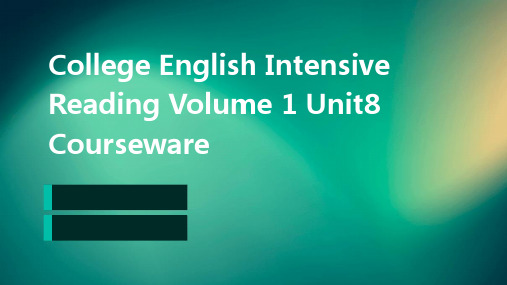
Sentence
Variety
The author varies sentence structure and length to maintain reader interest and ensure clear communication.
03 Grammar knowledge points
• Critical Thinking Activities: The course includes a range of critical thinking activities, such as analyzing themes, characters, and arguments in the texts.
Subjunctive mood
Subjunctive forms
The subjunctive mood is used to express wishes, hypotheses, or conditions that are not factual. This unit will familiarize you with the subjunctive forms of the verb and their usage in different contexts.
04 After class exercises
Multiple choice questions
• 题目1: Which of the following is NOT a type of literature?
Multiple choice questions
A. Poetry B. Drama C. Prose
题目2: Complete the following sentence with the correct form of the verb.
大学英语精读3课件 PPT

sensation
➢ a feeling that you get from one of your five senses,especially the sense of touch
大学英语精读3课件
➢ The title‘A Drink in the Passage’
➢ Why a drink? Why in the passage? What does that show?
Oral practice
➢May you offer an example on the importance of communication according to your own experience?
Questions to discuss
➢How come they made such a careless mistake?
➢Do you think the omission was intentional or accidental?
大家有疑问的,可以询问和交流
可以互相讨论下,但要小声点
➢to separate one group of people from others,esp because they are of a different race,sex,or religion~~integrate
Байду номын сангаас结合,合并
departure
➢ racial /major/significant departure from practice/the ordinary rule/traditional values
大学英语精读PPT课件

2021/3/7
CHENLI
9
2. Reading of the new words
apply /2=plai/ vi. write to ask for ( a job, membership, etc.), esp. officially 申请
application n.
2021/3/7
CHENLI
不赞成; 不满
CHENLI
Words16
colonel /=k2:nl/ n. 上校
private /=praivit/ n. soldier of the lowest rank 列兵;士兵
bootlace /=bu:tleis/ n.
shoelace for a high shoe or boot 靴带
Words19
carpet /=ka:pit/ n.
heavy woven material for covering floors or stairs 地毯
certificate /s2=tifikit/ n. 证(明)书
bloodshot /=bl0d53t/ a. (眼睛) 充血的
2021/3/7
obvious a.
2021/3/7
CHENLI
Words22
consist (of ) /k2n=sist/ vi.
be made up (of ) 组成,构成
range /reind6/ vi.
vary between certain limits (在一定范围内) 变动
cricket /=krikit/ n.
2021/3/7
express a strong objection 抗议;反对
大学英语精读讲课说课精品PPT课件

2
在学习、工作和社会交往中能用英语有有基本的了 解。
能力目标
培养学生的英语综合 应用能力,特别是听 说能力。
培养学生正确的语 言学习习惯,掌握 自主学习的能力。
1 2
3
能培养出一定的观察、 分析、归纳的英语学习 能力,提高综合文化素 养。
情感目标
1. 《大学英语》精读(预备级) 2. 《大学英语》精读(1-4册) 3.《大学英语》听说(预备级) 4.《大学英语》听说(1-4册) 5.《新世纪大学英语视听说教程》
(1-4册)
教材特点
1 题材广泛,体裁多样,提供丰富的 语言素材,具有趣味性、知识性和 可思性。
2 语言规范、内容完整和难易度适中。
情感目标
1.激发学生英语学习的兴趣,积极参与 学习过程。
2.培养学生创新精神和团结合作能力。
3.通过联系、综合和比较,形成自己的 价值观。
课程教学要求
教学要求分为三个层次:一般要求、较高要求、更高要求
听力理解能力
口语表达能力
阅读理解能力
教学要求 书面表达能力
翻译能力
推荐词汇量
课程使用的教材
遵照课程要求对大学英语提出的 教学目标,我们向学生提供了由上海 外语教育出版社出版的教育部推荐国 优教材,荣获高等学校第二届优秀教 材特等奖和国家教委高等学校第二届 优秀教材一等奖。
《》说课
说课主要内容
课程性质 课程目标 课程使用的教材 课程内容 教学过程 教学评估 课程教学设计
课程性质
大学英语精读作为高 校的主要课程,是非英语 专业大学生的必修的一门 语言基础课程,也是拓展 知识,了解世界文化的素 质教育课程。
课程教学目标
知识目标 能力目标 情感目标
大学英语精读第三册第五课说课课件The Day Mother Cried
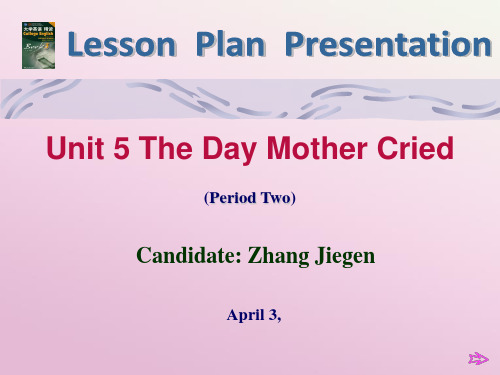
2023/3/12
4
Teaching Material
3) promote a harmonious relationship with parents
Make predictions for preliminary understanding
Background information
Teaching Material
This is the 2nd period of Unit 5, an introductory Lesson Plan Presentation
Learning Methods 第三版大学英语第三册课件
2023/3/12
5
Teaching Material
• Aims and demands
Students are supposed to 1) grasp the main idea and structure of the text 2) understand what a narration is, and its structure 3) promote a harmonious relationship with parents
• Audiolingual Method • Elicitation Method • Communicative Approach
2023/3/12
9
LeaCrOniNnTgEMNeTtShods
Lesson Plan Presentation
Comprehension questions
3) Can you guess the type of the text?
pMressaurke aendpvurlneerdabiilcitytaisoanhusmfanobreinpg.reliminary
大学英语精读讲课说课ppt课件
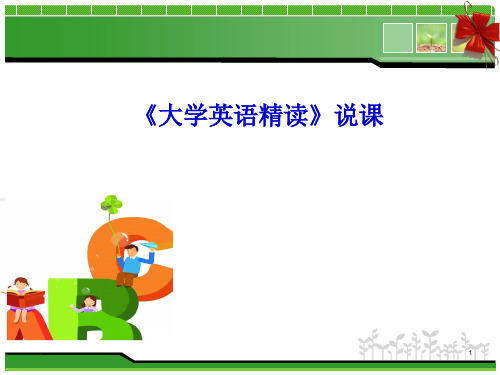
9
教材特点
1 题材广泛,体裁多样,提供丰富的 语言素材,具有趣味性、知识性和 可思性。
2 语言规范、内容完整和难易度适中。
3 练习多样,保证学生有足够的语言 实践机会。
4 阅读活动能有效提高学生阅读能力。
5 写作部分技巧讲解和练习安排合理。
10
课程教学内容
英语语言知识与应用技能
教学内容
1.He is a library. 翻译 他知识渊博。
2. He is a hospital. 翻译 他疾病缠身。
39
Teaching Procedure
Before Reading
text
Global Reading Detailed Reading
After Reading
40
Questions to the Text
metaphor
language is so vivid(语言生 动)
enhance the expressive force of language (增强表现力)
indicate something profoundly (表述深刻)
38
metaphor(暗喻)的练习
例:All the world is a stage.(Shakespeare) 人生就是舞台。(莎士比亚)
During-task(课中任务) 教学过程中学生以个人、伙伴或小组形式完成各项任务,并 汇报其完成情况:课中任务强调学生参与课堂教学,在实践 中发现问题和解决问题 。
Post-task(课后任务) 每一单元结束后学生需巩固和操练语言知识的任务,课后任 务强调复习环节的重要性,使学生养成总结的习惯,从而提 高他们自我管理和自主学习的能力。
大学英语精读课件 [上册]Unit OnePPT幻灯片
![大学英语精读课件 [上册]Unit OnePPT幻灯片](https://img.taocdn.com/s3/m/9f842f90b307e87100f6967e.png)
and is now outdated; stereotyped phrase; trite expression 陈腔滥调 3. scrutinize v..make a detailed examination of 细查,详审; 审视
Menu
That customer was in a bad mood, he thinks. When things go right, the optimist takes credit﹡ while the pessimist sees success as a fluke﹡.
1. credit※ n. honour, approval, good name or reputation荣誉; 赞许;好名声
2. fluke n. something resulting from a fortunate accident; lucky stroke侥幸的结果;侥幸
Menu
Translation
[ 7 ] Craig Anderson had a group of students phone strangers and ask them to donate﹡ blood to the Red Cross . When they failed on the first call or two, pessimists said, "I can't do this." Optimists told themselves, "I need to try a different approach." [ 8 ] Negative or positive, it was a self-fulfilling prophecy﹡. "If people feel hopeless, "says Anderson, "they don't bother to acquire the skills they need to succeed."
The Fun They Had 大学英语精读 教学课件(共13张PPT)
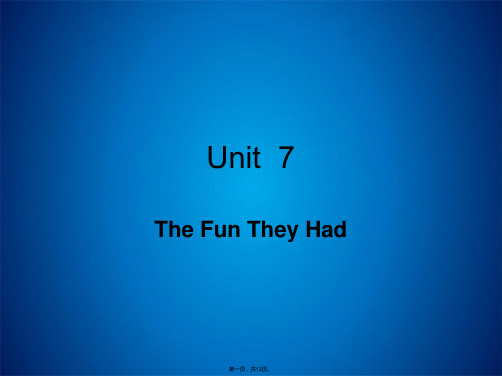
5. He failed in the college entrance examination last year, but he did not feel disappointed. Instead, he continued to study hard, passed the examination successfully and became a student in a famous university this year.
• 8) With his shirt tucked into the top of his trousers and a leather bag tucked under his arm, the boy looked just like a boss.
• 9) Although she is only eight years old, the little girl is already very good at calculating fractions. No wonder her parents feel very proud of her.
2. It is awfully funny and splits your ideas with laughter to observe these caricatures which satirize social ills.
3. Computers are one of the most useful teaching aids, for all your lessons as well as all the questions asked and all the answers provided can be shown on a screen.
最新lesson 1 现代大学英语精读5 第二版讲课稿

• Why do the administrators fear the students?
• What has the author learnt from Emerson and Freud respectively?
Part VIII (Paras. 35-38)
• What attitude should the students hold towards those famous writers?
Part III (Paras. 5-7)
• What is his father’s reaction to the author’s plan to major in law in college?
• How about your parents’ opinions towards your major?
• 第一个题目作文号:482680, Reflection over the BBC Documentary.
• 第二个题目作文号:482682 My View on the Problems of College Education in China.
• You can revise your essay as many times as you like and you have to print the one you are satisfied with and hand in it to me before the National Day Holiday.
大学英语精读第三版第册 PPT

Useful expressions
▪ Plastic surgery ▪ 整形外科
▪ The Making of a Hero
▪ 城镇居民 ▪ 紧急呼叫 ▪ 松懈(努力) ▪ 念叨过去
▪ 钢铁就是怎样炼成得 ▪ City residents
▪ Emergency call
▪ Relax one’s efforts ▪ Dwell on the past
confident?
Text interpretation
▪ Answer the questions
Ⅱ prehension 2 on p、144
▪ What type is the text, generally?
A、 narration B、 exposition C、 description D、 argumentation
1. I asked myself the question: What makes a surgeon? 2. The answer, I concluded, was self-confidence、 3. During the first months I was diffident and indecisive、 4. In the last month I grew confident and decisive、 5. In the operating room I was equally confident、 6. Nor was I afraid of making mistakes、 7. A surgeon needs conceit to encourage himself、
▪ More words on pp 147-8
- 1、下载文档前请自行甄别文档内容的完整性,平台不提供额外的编辑、内容补充、找答案等附加服务。
- 2、"仅部分预览"的文档,不可在线预览部分如存在完整性等问题,可反馈申请退款(可完整预览的文档不适用该条件!)。
- 3、如文档侵犯您的权益,请联系客服反馈,我们会尽快为您处理(人工客服工作时间:9:00-18:30)。
教学方法
启发式教学法 多媒体演示法 情景教学法 任务教学法
学习方法
目标学习法 问题学习法 合作学习法 归纳学习法
明确学习 重要目标, 增强学习 的注意力 与学习动 机,能形 成自我测 验的习惯。
发现问题、 分析问题、 解决问题, 使学习有 了明确的 指向性, 从而提高 学习效率。
形成学生之 间的全方位 的交流模式, 使小组中每 个人都有机 会发表看法, 达到学会、 会学、乐学 的目标。
归纳语言知 识点,搜索 相同、相近、 相反的知识, 进行识记与 理解,能起 到更快地记 忆、理解的 作用。
教学评估
形成性评估(平时): 设立课堂活动和课外活动记录,以便对学生学 习过程进行观察、评价和监督,促进学生有效 地学习(占学生总成绩的30%)。 终结性评估(期末): 设立期末考试考核项目(占学生总成绩的70%)
Before Reading
In 1929, Francis Chichester made a solo flight (单人飞行) to Australia in a biplane.
Before Reading
Gipsy Moth
Teaching Procedure
Before Reading Global Reading
本堂课设计
教学内容
该课文材料选自《大学英语精读》第一册 Unit2,是关于一位富有冒险精神的传奇人物, 他不懈追求,永不言败,敢于创新的精神让学 生得到启迪。
本堂课重点与难点
教学重点:
1.掌握重点的单词和暗喻的修辞方法并灵活运用。
2.了解主人公的航海路线图,学习到这篇文章
所赋予的情感目标。
教学难点: 1.如何引导学生理解文章。 2.指导学生用英语口头谈论内容。
掌握标准语音语调、重点词语、语法和基本 交流句型的英语语言基础知识。
在学习、工作和社会交往中能用英语有效地 进行交际和应用。
对跨文化国家的国情、风俗文化有基本的了 解。
能力目标
培养学生的英语综合 应用能力,特别是听 说能力。
1
2
能培养出一定的观察、 分析、归纳的英语学习 能力,提高综合文化素 养。
Detailed Reading
succeed v. 成功
succeed in doing something 成功做某事 他成功地航游世界。
翻译 He succeeded in sailing round the world.
1.Failure is the mother of _________. success successful businessman. 2.Bill Gates is a ___________ 3.If you are determined to do one thing, you will ________ succeed one day.
Antarctica
Global Reading
route of voyage(航海路线)
back to England
May28
set off from England
Aug.1966
arrived in Sydney
Dec.12
left Australia
Jan.29,1967
Global reading
Unit Two
Sailing Round the World
Teaching Procedure
Before Reading Global Reading
text
Detailed Reading After Reading
Before Reading
Do you like adventures(冒险)? Who is the adventurer you admire most?
indicate something profoundly (表述深刻)
metaphor(暗喻)的练习
例:All the world is a stage.(Shakespeare)
人生就是舞台。(莎士比亚) 1.He is a library.
翻译
他知识渊博。
2. He is a hospital.
教材特点
1 题材广泛,体裁多样,提供丰富的 语言素材,具有趣味性、知识性和 可思性。
2 语言规范、内容完整和难易度适中。 3 练习多样,保证学生有足够的语言 实践机会。 4 阅读活动能有效提高学生阅读能力。
5 写作部分技巧讲解和练习安排合理。
课程教学内容
英语语言知识与应用技能
教学内容
英语学习策略
28,500 miles Length of voyage:_______
Global Reading
In 1967, he was knighted by Queen Elizabeth II. (授予爵位)
Teaching Procedure
Before Reading Global Reading
课程教学的难点
1.从教学计划来看,利用有限的学时提高学生语言表 达能力。 2.从教材内容来看,篇幅较长,内容广泛,对学生的 理解和归纳能力要求偏高。 3.从学生来看,英语水平差异较大。
教学过程
Pre-task(课前任务) 学生课前需要思考和完成任务的要求和实施任务的步骤。 强调自学和预习过程,使学生可以带着问题走进课堂 。 During-task(课中任务) 教学过程中学生以个人、伙伴或小组形式完成各项任务,并 汇报其完成情况:课中任务强调学生参与课堂教学,在实践 中发现问题和解决问题 。 Post-task(课后任务) 每一单元结束后学生需巩固和操练语言知识的任务,课后任 务强调复习环节的重要性,使学生养成总结的习惯,从而提 高他们自我管理和自主学习的能力。
the greatness of Francis Chichester
65 years old; ________ lung ______ cancer single -handed round the world sailing ______ 9 Time of voyage:______ months
Columbus
Zheng He郑和
Before Reading
At sixty-five the British adventurer Francis Chichester set out to sail single-handed round the world.
65岁的英国冒险家弗朗西斯· 奇切斯特独自一人航游世界。
跨文化交际知识
教学模式
教学对象 教学内容
听 说 学生
读
写
译
教学环境 教学方式
计算机
课堂教学
(单机或网络)
面授+自学
面授
教学组织者
教师
课程教学的重点
1.大学英语课程重点培养学生的英语综合能力,特别是 听说能力,使他们能够使用英语进行交流;
2.英语学习与学生的实际应用联系起来; 3.使学生了解西方文化,提高学生综合文化素养。
《大学英语精读》说课
说课主要内容
课程性质
课程目标 课程使用的教材 课程内容 教学过程 教学评估
课程教学设计
课程性质
大学英语精读作为高 校的主要课程,是非英语 专业大学生的必修的一门 语言基础课程,也是拓展 知识,了解世界文化的素 质教育课程。
课程教学目标
知识目标
能力目标
情感目标
知识目标
1 2 3
Questions to the Text
3. Who knighted Francis Chichester in 1967? A) Queen Elizabeth I. B) Queen Elizabeth Ⅱ. C) King William. D) King George V.
4. What do you know about his boat? A) Its name was Titanic. B) It was 60 meters long. C) Its name was Gipsy Moth. D) It was 16 meters wide.
the significance(意义) of his sailing round the world
世界地图
Arctic Ocean
Europe
Asia Africa Atlantic Ocean Indian Ocean Pacific Ocean
North America
Oceania
South America
Detailed Reading
修辞方法——metaphor(暗喻、隐喻) Wild horses could not drag me down to Cape Horn and the sinister Southern Ocean again.
本体:wild horses 喻体:something powerful nothing ,no matter how strong, could make me down to Cape…
翻译
他疾病缠身。
Teaching Procedure
Before Reading Global Reading
text
Detailed Reading After Reading
Questions to the Text
1. Who was Chichester? A) An American artist. B) A British musician. C) An Australian writer. D) A British adventurer. 2. Before Chichester began his sailing, he was_____. A) a businessman B) a pilot C) a teacher D) a doctor
